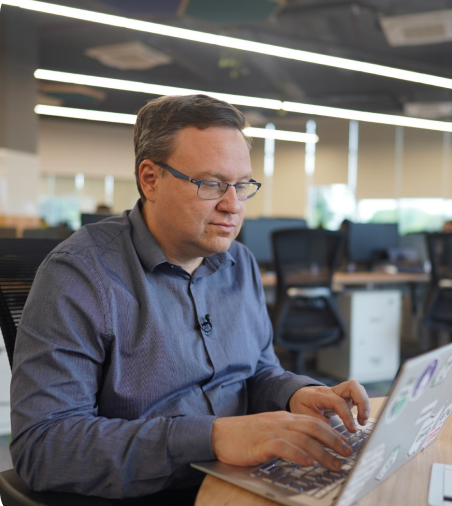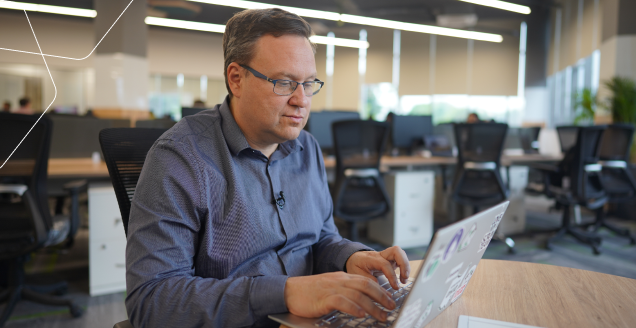Facial Recognition: Putting a Name to a Face

A Face in a Crowd
You can probably find a friend’s face in a small crowd. When the crowd size is thousands or millions, however, finding that one familiar face becomes impossible.
That’s where facial recognition software comes into play.
Facial recognition (also known as “liveness”) has been gaining considerable traction for the past few years. The technology has been used for security and surveillance, multimedia data management, and identity verification—including unlocking your smartphone.
Its use has also expanded into robotics, medical analysis, and targeted marketing. More companies are finding new ways to use facial recognition as access to this technology becomes more affordable.
In this whitepaper, we take a general look at how facial recognition systems work and the various ways they are being used. We also outline what to consider when shopping for a facial recognition vendor.
Your Data Is Written on Your Face
Your face is the most common way of verifying your identity. It’s on your driver’s license, your passport, and other forms of state- and company-issued ID. Like your fingerprint, your face is unique to you.
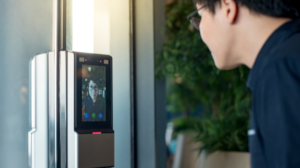
Unlike your fingerprint, however, you can be identified by your face from a distance. That makes facial recognition substantially more useful than fingerprints for an array of real-world applications.
The latest advances in computerized facial analysis make it possible to develop automated systems that recognize faces and interpret facial gestures. Forward-thinking companies are already seizing upon systems like these. The most well-known is Apple’s iOS function that unlocks your iPhone simply by pointing it at your face. Other examples include:
- The global e-commerce giant Alibaba, which has come up with a “smile to pay” service at food outlets in China. Once registered, customers don’t need to carry a wallet or even a phone to use the service. They simply smile at checkout and facial recognition does the rest.
- Facebook, which gives users the option to turn on facial recognition for identifying and automatically tagging them in photos posted on the social media giant’s platform.
- Sony’s robot dog, Aibo, which has a camera in its nose and facial recognition technology, so it can identify people around it and react accordingly.
- The United Kingdom rail system, where facial recognition could soon replace ticket-checkers on commuter trains.
- The Civil Aviation Authority of Singapore, which is using a facial recognition system for the automation of its services like boarding, immigration, and bag drop.
How Facial Recognition Works
Facial recognition systems work by capturing an image of your face and analyzing its nodal points. Nodal points are distinguishable features, elevations, depressions, and so on. Each human face has approximately 80 nodal points, such as:
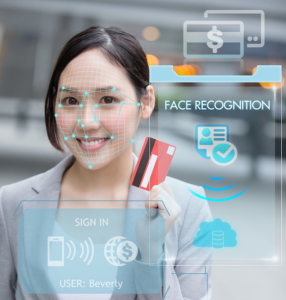
- Jawline length
- Distance between the eyes
- Cheekbone shape
- Eye socket depth
- Nose width
Facial recognition algorithms convert the measurements of nodal points into a mathematical function. This mathematical function becomes your digital faceprint. The system then compares your faceprint to all available faceprints in its database.
If a match is found, the system executes the success condition—for example, charging your account for a purchase or unlocking a door. If no match is found, then it executes the failure condition—alerts a cashier to assist you, doesn’t unlock the door, or whatever else it’s programmed to do if it can’t find your faceprint.
Applications
We’ve touched on a few use cases for facial recognition, but let’s look at three real-world examples in a bit more depth.
Access Control
In highly restricted areas, security guards or law enforcement officers often verify your identity by comparing your face to the photo on your ID or in their system. Facial recognition makes this exercise more convenient and accurate.
In one Canadian casino, for example, security personnel were able to recognize more than 10,000 problematic gamblers in time to keep them away from the gaming tables using facial recognition. The system captured an image of each person as they entered and compared it with a database of offenders. If it found a match, security personnel received an alert and stepped in to restrict the identified offender from entering. If it didn’t find a match, the image was deleted to protect the privacy of the non-offending casino patrons.
You can probably see how a similar access control system could be used in the workplace. Facial recognition technology can easily automate attendance and even eradicate “buddy punching” among employees who must clock in and out. It can also prevent non-employees from entering the workplace.
Facial-based security measures can also be used control access within the workplace. For example, your business needs to keep unauthorized employees from entering restricted areas, but you can’t afford to post a guard at every door. A facial recognition system can keep the area secure without needing extra personnel. It can also track who entered the area, when they entered, and when they left.
Customer Identification
Facial recognition can also be used in retail settings to elevate customer service and increase engagement with your best customers. One way this might work is with a camera at the entrance capturing an image of each person as they enter. The system sends the image to a remote server, where it’s compared against a database of your premium customers.
If the algorithm finds a match, the system immediately sends you message with the customer’s preferences and any other information that might enhance their shopping experience. The system may even analyze previous purchases to give you suggested offerings. And it all happens within seconds of the customer entering your store.
But what if the customer is wearing of sunglasses? Radically changed their hairstyle? Grown a beard or shaved one off? No problem. Because the system compares against those 80 nodal points, it will correctly identify the customer anyway.
Law Enforcement
When trying to track a suspected criminal, law enforcement officers must often search through hours of videography from several different cameras. Facial recognition systems have the power to drastically reduce that time.
The United States Federal Bureau of Investigation (FBI) spent more than one billion dollars to build a next-generation identification program. The FBI’s program added biometric markers such as facial recognition, voice identification, DNA analysis, and iris scanning to the toolkit of the security agencies.
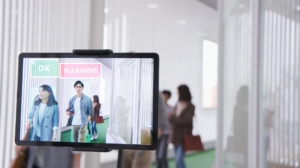
Facial recognition brings a higher level of automation and efficiency in the workflow of investigation. This technology sees extensive use at border checkpoints and crime-prone areas, helping to identify missing persons and track the movements of criminals.
It may soon see use in identifying criminals within large crowds, such as riots. Security agencies may be able to examine the video footage and pinpoint the people who instigated the riot. Given the multi-tiered nature of the database, facial recognition technology would have to be deployed on a cloud-based server.
How to Choose a Facial Recognition System
Facial recognition has become an industry. The 2020 pandemic fueled its growth as businesses sought to enhance security and install touchless systems for interacting with their customers.
If you’re thinking of installing a facial recognition system, you have a growing number of options to choose from. Major tech companies like Amazon, Google, IBM, and Microsoft have massive systems, and several smaller businesses offer off-the-shelf solutions, as well.
How do you choose the best solution for your needs? Here are a few questions to consider.
What is the system’s accuracy and speed?
The accuracy and speed of the system depend upon the vendor’s method for facial detection. The system should be able to compensate for the factors that impact facial detection—sunglasses, facial hair, angle of the head, background light, and so on.
It should also be able to correctly mark all the nodal points of the face to generate a precise mathematical faceprint. And it should be able to quickly determine if the faceprint matches any record in its database.
And how large is the vendor’s database? It should be large enough to offer meaningful matches for your needs. An office building will only need a database of employees, but a hospital may need a database that encompasses the residents of the area it services.
Independent third-party tests are a good measure of the accuracy and speed of a facial recognition system.
What would be the cost of the system?
Facial recognition systems can vary in cost, depending on the underlying platform and what is provided for the price quoted. For example, software that involves neural networks and deep learning will not be cheap.
Things to keep in mind when asking about cost:
- Facial recognition requires both hardware and software, so make sure the quote you get is for both.
- Ask the vendor to provide you a breakdown of the charges per feature. You’ll know exactly what you’re getting and where you might be able to trim.
- Ask about recurring fees. Some vendors charge periodic fees for security, maintenance, and updating.
- If the solution involves deep learning, ask there’s a cost per update and how often updates occur.
Can the vendor expand the system in emergencies?
The definition of “emergency” depends on how you plan to use facial recognition. If you’re in retail, for example, an emergency may be your Black Friday sale. For a landlord using it to control access to a building, a riot or attempted break-in is an emergency. Regardless, you need to know how the system will perform under stress and if it can provide timely analytics in that situation.
Some facial recognition vendors provide their systems as a standalone service, made to integrate with your other systems as needed. How will that affect performance?
The size of the vendor’s database comes into play here, too. Can the system analyze and store a large number of images when demand peaks? The answer to this question not only determines performance in an emergency, but also the scalability of the system as your needs grow.
Taazaa’s Facial Recognition System
At Taazaa, we continually explore new technologies, including facial recognition. We’ve developed our own facial recognition system that can be easily tailored to fit your specific business needs. It uses three-dimensional image modeling to scan the nodal points of each face and rapidly compare it to our database.
The most prominent of the facial features used in our modeling process include the cheekbones, rigid tissues, chin, nose, and eye sockets. These unique features don’t change over time, enabling our system to identify people with high competency: When tested against 10,000 labeled faces in wild dataset, our system had a 99.20% accuracy.
Moreover, our three-dimensional facial recognition system doesn’t lose its utility in low light situations, because it can recognize a person at various angles of view.
Three-dimensional facial analysis is one of the most prominent features of Taazaa’s facial recognition system, which has resulted in near-perfect matches.
The Face of the Future
Facial recognition systems have proven their worth, and their use will only grow from here on out. As access to this technology expands, we’ll see innovative uses for facial recognition in security, entertainment, customer engagement, and more.
In what fresh ways do you want to use facial recognition? Give us a buzz and let us help you bring your ideas to life.
About Taazaa
Taazaa means “fresh.” Think new. Not canned. Tailored to you. We work with like-minded people and organizations looking for a fresh experience around creating and unleashing great software.
Since 2007, Taazaa has helped hundreds of mission-minded organizations stay relevant in a world of relentless change. Leveraging custom software solutions and emerging technology, we follow design-based development practices that promote rapid delivery and a tailored fit to your business.
We’re agile. We’re high-empathy and low-friction. And we make great software.
